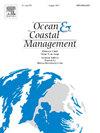Participatory mapping of marine ecosystem services in the Cabo de Gata-Níjar Natural Park (Spain)
IF 4.8
2区 环境科学与生态学
Q1 OCEANOGRAPHY
引用次数: 0
Abstract
Marine ecosystems are a source of ecosystem services for people globally. Recent efforts for marine conservation and preservation of marine ecosystem services (MES) have increased worldwide through the creation of marine protected areas (MPAs). However, standardized methods for integrating MES in MPAs planning and management remain poorly assessed. Here, based on knowledge from expert and local stakeholders, we applied participatory mapping technique to assess the spatial distribution of MES in the MPA of Cabo de Gata-Níjar Natural Park (SE Spain) with the goal of informing its spatial planning. Firstly, we conducted in-depth semi-structured interviews with key local stakeholders and experts to elicit their knowledge regarding MES importance. Secondly, we evaluated the spatial distribution of MES delivery within the Cabo de Gata MPA boundaries. Finally, we characterized and mapped the hotspots of MES delivery within the MPA. Additionally, this methodological approach allowed to map cultural MES, traditionally overlooked since they are difficult to assess in marine systems. Overall, local stakeholders and experts perceived that the study area has a high capacity to provide MES to people, specifically habitat maintenance, scenic landscape values, environmental education, and local knowledge. A high spatial variability of MES delivery was observed within the MPA, with regulating MES concentrated in the integral reserve areas (i.e., core zone of maximum protection) and cultural MES along the coastline. Hotspots of regulating MES overlapped core zones, while hotspots of cultural MES pointed out new areas within the MPA that demand attention by managers. Finally, we reflect on the utility of including participatory mapping procedures in management and planning of this and other marine protected areas.
Cabo de Gata-Níjar自然公园海洋生态系统服务参与式制图(西班牙)
海洋生态系统是全球人类生态系统服务的一个来源。最近,通过建立海洋保护区(MPAs),世界范围内的海洋保护和海洋生态系统服务(MES)保护工作得到了加强。然而,将MES纳入海洋保护区规划和管理的标准化方法仍然评价不足。在此,基于专家和当地利益相关者的知识,我们应用参与式制图技术来评估Cabo de Gata-Níjar自然公园(西班牙东南部)MPA中MES的空间分布,目的是为其空间规划提供信息。首先,我们与主要的本地利益相关者和专家进行了深入的半结构化访谈,以了解他们对MES重要性的认识。其次,我们评估了MES在加塔角MPA边界内的空间分布。最后,我们描述并绘制了MPA内MES交付的热点。此外,这种方法方法允许绘制文化MES,传统上被忽视,因为它们难以在海洋系统中进行评估。总体而言,当地利益相关者和专家认为,研究区域具有很高的能力为人们提供MES,特别是栖息地维护,风景景观价值,环境教育和当地知识。海洋保护区内生态系统MES的空间变异性较大,调控生态系统MES集中在整体保护区(即最大保护核心区)和沿海岸线的文化生态系统MES。规范MES的热点与核心区重叠,文化MES的热点则指出了MPA内部需要管理者关注的新领域。最后,我们反思了将参与式测绘程序纳入这一和其他海洋保护区的管理和规划中的效用。
本文章由计算机程序翻译,如有差异,请以英文原文为准。
求助全文
约1分钟内获得全文
求助全文
来源期刊

Ocean & Coastal Management
环境科学-海洋学
CiteScore
8.50
自引率
15.20%
发文量
321
审稿时长
60 days
期刊介绍:
Ocean & Coastal Management is the leading international journal dedicated to the study of all aspects of ocean and coastal management from the global to local levels.
We publish rigorously peer-reviewed manuscripts from all disciplines, and inter-/trans-disciplinary and co-designed research, but all submissions must make clear the relevance to management and/or governance issues relevant to the sustainable development and conservation of oceans and coasts.
Comparative studies (from sub-national to trans-national cases, and other management / policy arenas) are encouraged, as are studies that critically assess current management practices and governance approaches. Submissions involving robust analysis, development of theory, and improvement of management practice are especially welcome.
 求助内容:
求助内容: 应助结果提醒方式:
应助结果提醒方式:


